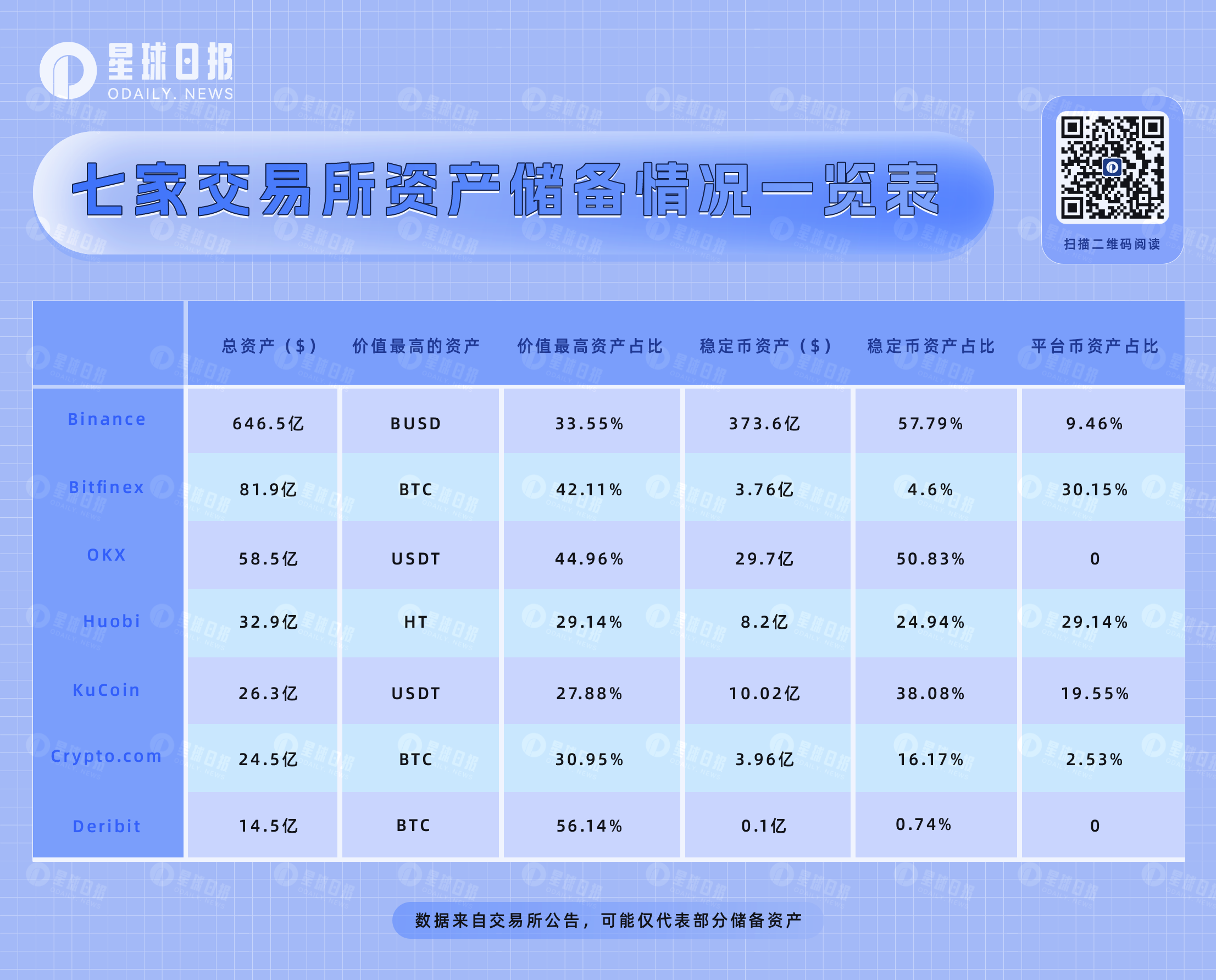As the FTX incident continues to ferment, the reserve assets of centralized exchanges have become the focus of attention in the encryption market, and every ordinary user is worrying day and night: Who is likely to be the next thunderstorm?
In the past week, several platforms have successively conducted transparency announcements, disclosing some of the wallet addresses of reserve funds. The encrypted data website Nansen collected the wallet address data of seven encrypted trading platforms including Binance and OKX, and Odaily analyzed them and found some noteworthy information.

Overall, Binance has announced the most reserve assets at present, with 64.65 billion U.S. dollars in assets, Bitfinex (8.19 billion U.S. dollars) and OKX (5.85 billion U.S. dollars) ranked second and third respectively; Deribit has the least reserve assets , is 1.45 billion U.S. dollars-the platform focuses on encrypted option derivatives transactions, and it is expected that the reserve assets are not as good as the big platforms.
It is worth noting that it may be inaccurate to judge the health status of exchange reserve assets through vague "total asset value". , SRM and other liquidity problems, and the proportion of FTX and Almeada currency holdings is too high. When there is a stampede, the liquidity may be drained for a short time, and eventually a series of stampedes will be formed as the price collapses.
Therefore, for trading platforms, the higher the proportion of non-volatile assets (mainly stable coins), the more trustworthy they are obviously, and the more liquid mainstream assets (BTC & ETH) are relatively safer, while other small currencies account for more If the ratio is too high, vigilance is obviously required.
CZ, founder of Binance, also mentioned this in his AMA on the evening of November 14th. He believed that “in a bear market, if there is not a considerable proportion of stablecoins in the reserves announced by the exchange, there may be potential risks.”
From the perspective of individual reserve assets, Binance reserves the most in BUSD, reaching 21.64 billion US dollars (accounting for 33.49%); USDT ranks second, reaching 13.66 billion US dollars (accounting for 21.14%); BTC and ETH rank third and third. Fourth, the sum of the proportion is 20.45%; the Binance platform currency BNB ranks fifth, reaching 5.98 billion US dollars (accounting for 9.26%).In general, the total assets of Binance stablecoins (BUSD, USDT, USDC, TUSD) accounted for 57.79%, and the reserve assets are in a healthy state.
Another stablecoin reserve accounting for more than 50% is OKX. The stablecoin asset scale (USDT, USDC, USDK) is 2.97 billion US dollars, accounting for 50.83%; and the highest single reserve asset is also USDT, reaching 2.63 billion US dollars ; The sum of BTC and ETH assets accounted for 48.2%, and the overall reserves are in good condition.However, the asset reserve announced by OKX does not include its platform currency OKB, which may be because its wallet address has not been fully disclosed.
The asset with the most reserves on Bitfinex is BTC, accounting for 42.11%; ETH reserves rank third, reaching 21.45%; stablecoins USDT and EURT (euro stablecoins) account for 4.51%; the sum of several assets reaches 68.07%.However, another 30.15% of the reserve assets on the platform are its platform token LEO.
Huobi's current asset reserves are worth noting.The largest reserve asset on the platform is its platform token HT, accounting for 29.14%; in addition, TRON’s native token TRX ranks fifth in Huobi’s reserve assets, accounting for 14.73%; the sum of the two reached 43.87%.The combined proportion of BTC, ETH and USDT is 43.16%.
In addition, according to Nansen monitoring, the address marked Huobi 34 (starting with 0xcac725) held 14,858 ETH when Huobi took an asset snapshot (at 0:00 on November 13); after the snapshot, the address had transferred 10,000 ETH To Binance and OKX deposit wallets.
The largest single asset in Kucoin’s asset reserves is USDT, accounting for 27.88%, and its stablecoin total assets account for 38.08%; together with BTC (11.22%) and ETH (8.07%) reserves, the total accounted for 57.37%. In addition, the exchange platform currency KCS reserves accounted for 19.55%, ranking second.
Deribit mainly focuses on option derivatives transactions, and the main trading volume comes from currency-based options transactions. Therefore, the largest reserve assets are BTC and ETH, and the sum of the two reaches 98%.
What needs to be paid attention to is Crypto.com. Recently, there have been endless discussions about its potential "explosion" risk. From the perspective of asset reserves, its first and second assets are BTC (30.95%) and ETH (15.17%),The third place is MEME coin SHIB, with a reserve ratio of 20.91%.The stable currency USDC accounts for 9.9%, and USDT accounts for 5.26%. There are indeed certain potential risks.
Finally, Odaily needs to remind the majority of users that these on-chain asset reserve announcements cannot fully represent the solvency of the trading platform. The professional audit report issued by a third-party organization has certain authority, but it cannot indicate whether the assets have not been transferred for a long time. and change. CZ mentioned that he is working with Vitalik to build a new proof-of-reserve protocol. He sincerely hopes that such products can be launched as soon as possible. The black box operation hurts the most is always ordinary investors.
Of course, this publicity of asset reserves on the chain can be regarded as a progress for the industry. If a platform is not even willing to do the first step, how can it gain the long-term trust of users?